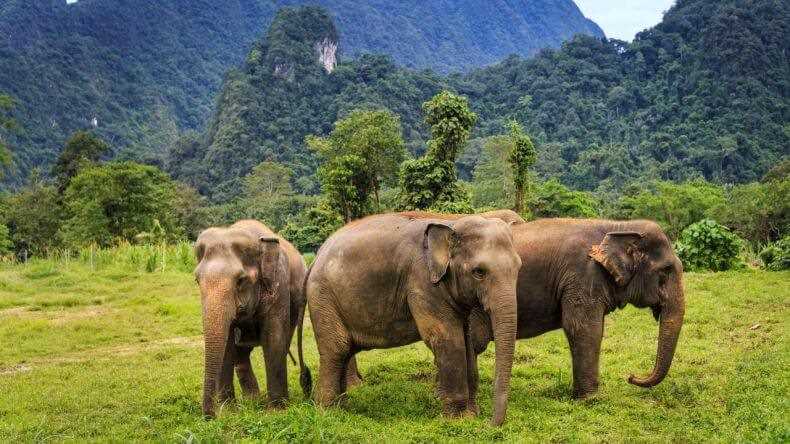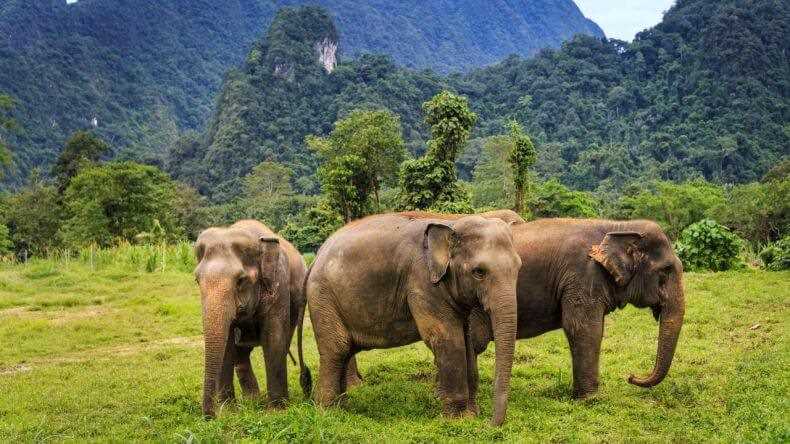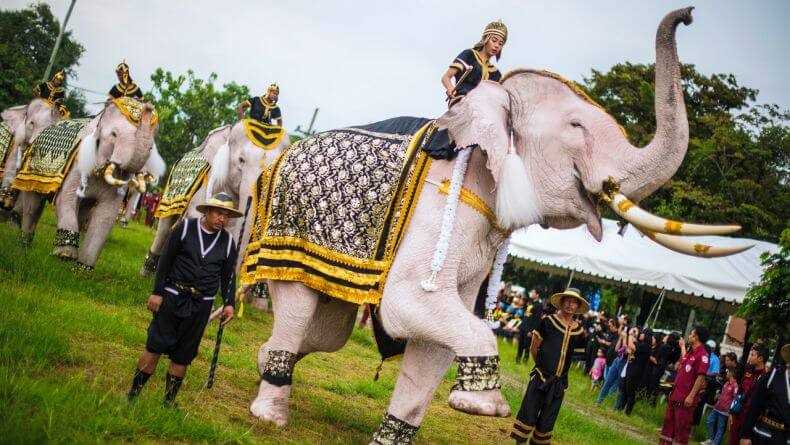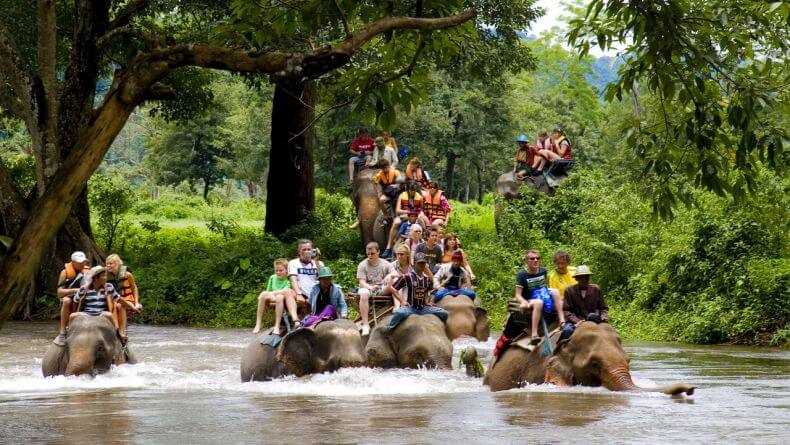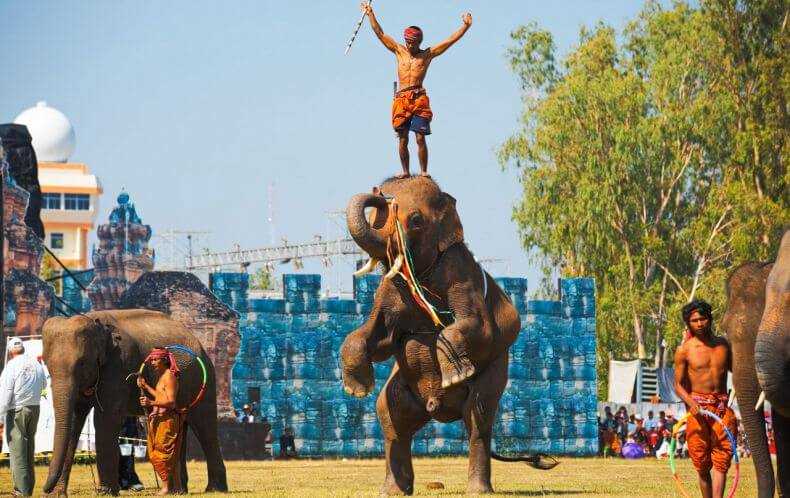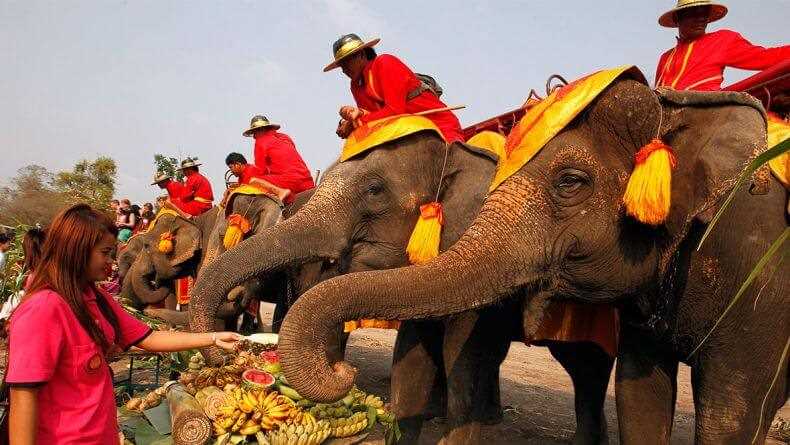Elephants in Thailand are some of the most remarkable animals. It’s not just the size and unusual body shape. They have a well-developed intellect and are aware of themselves as individuals. All this arouses genuine interest among tourists, especially if there is an opportunity to communicate with these gray giants in person. So the question, “Are there elephants in Thailand?” is asked by almost everyone who goes there for the first time.
The first meeting with a Thai elephant is a storm of emotions. It’s always a little scary to see a city-like living thing next to you. At the same time, you feel childlike delight. After all, in the eyes of the animal so much intelligence that it seems as if it is about to say hello and talk, shaking a huge head.
Elephants are very emotional. If they don’t like something, they are frowning and thoughtful, in the mating season they can be inadequate, and when in a good mood animals can joke. Both with fellow tribesmen and with random passers-by. They have a great sense of rhythm, they are able to memorize music. Sometimes we can spy a moment when an elephant entertains itself by rhythmically dancing to an unknown tune that it “spins” in its head.
Elephant species
.
There are currently two types of elephants. These are the African elephant and the Indian elephant. The latter is also called the Asian elephant. It is they who live in Thailand.
Indian elephants are also known as Asian elephants.
- Asian elephants are smaller than African elephants. The inhabitants of the savannahs of the Black Continent are up to 7.5 meters in height at a withers and weigh about seven tons. Its Indian counterpart is never taller than 3.5 meters and weighs more than five tons.
- Ears are more characteristic of African elephants. The ears of Asian elephants are relatively small and strongly pointed to the bottom.
- If there are two appendages at the tip of the trunk, it is an African, while Asians have only one “finger.”
- Tusks are also different. Females do not have them at all, and males are small and almost straight. Unarmed males can also be found. African elephants have long and curved tusks.
- The skin of Indian elephants is relatively smooth, and its color is not only dark gray, but also brown. Africans, on the other hand, are brown and have more wrinkles in their skin.
African elephants are aggressive, they are almost impossible to train. Indian elephants, on the other hand, are peaceful (to a certain extent) and friendly. But this is the result of centuries of selection, because in this part of the world elephants were used as working animals. Angry and dangerous animals were simply not allowed to breed.
History-and-legends
There are many religious rituals associated with elephants. In the Hindu pantheon, the god of well-being and wisdom, Ganesha, has the head of an elephant. This is why giants are loved and respected with sacred awe.
The elephant is the sacred animal of Thailand and a national symbol. It represents the trinity of the religious spirit, the king and the people. It now appears on the Thai navy flag and, before 1917, on the national flag as well.
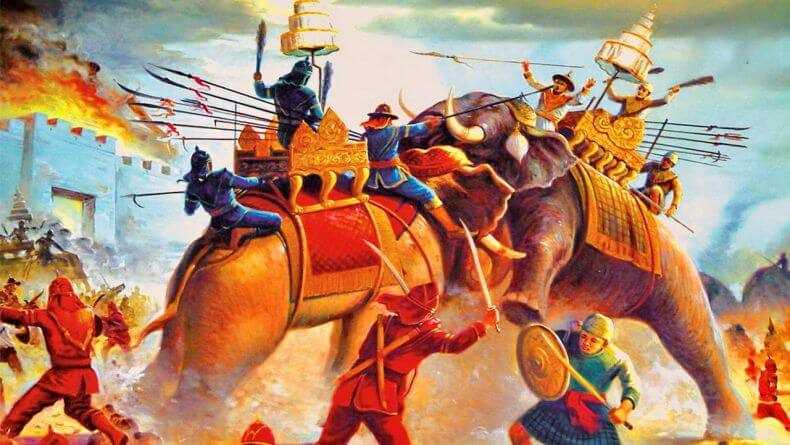
Traditionally, Thai elephants have been used as vehicles and for clearing the jungle. In battle, when they’re angry and frightened, they no longer distinguish their own from the outsiders, and so they put more psychological pressure on their enemies. To date, they are assigned the role of artists in various shows, and riding elephants in Thailand has become part of most sightseeing programs. And it is very popular among tourists. However, in remote areas of the country, they still haul weights and do other work.
Royal white elephants in Thailand
.
The white elephant in Thailand is classified as a symbol of royalty. There is a special law under which His Majesty has a special right of possession over all albino elephants. The subject, who found and handed over to the palace of such an animal, is provided with lifelong support. Therefore, among the people they are also a symbol of good luck. The status of the main national animal for Thai white elephants was established in 1963 by a decree of the Royal Forest Department.
Albinos (Chang Samkhan) are given a particularly comfortable environment, surrounded by attention and unconditional love. Among the many government institutions there is one that is solely dedicated to providing for their care. White elephants are not used for work. Only in religious ceremonies involving royalty. Most Thais can only dream of such a fate.
Daily-life
.
No one will tell you the exact number of elephants in Thailand. But the role of these animals in the daily life of the country is very great. The use of the giant power of the intelligent animal in agricultural work, construction and warfare is a national tradition. There is no better means of transportation in the jungle without roads.
The common gray elephants don’t have the same wonderful life as the white elephants. They are kept on elephant farms and work from the age of fourteen until their old age of sixty. Nevertheless, even these ordinary citizens can only envy them, because a separate chapter of the country’s constitution is devoted to elephant rights and the regulation of their application.
For example, the working day of the giants may not exceed eight hours, all of them are provided with health insurance and undergo regular check-ups. Their working age limit is 60 years, but most animals do not live up to it. The average elephant’s working age is 55 years.
Pension for elephants in Thailand is 5000 baht. Even those who are their owners can’t count on such a sum. However, it is justified by the animal’s large appetite. In a day, it eats such an amount of green mass, which is equal to 8% of its weight.
The gray elephant, while respected and worshipped, is a working cattle. Therefore, you can buy it if you are sure you can keep it.
How much does an elephant cost in Thailand? There is no definite answer to this question. It is usually guided by the weight of the animal, its age and the degree of its training. On average, the price of the question is from 1 to 3 thousand dollars.
This is not much by Russian standards, but it would be a smarter move to buy only a souvenir of an elephant from Thailand. For the reason that it is very difficult to build a hierarchy of relationships with the animal.
How elephants are raised and trained
.
The elephants’ childhood ends at age three. At this age, they are separated from their mother and begin training (read more about How elephants are trained in Thailand). A close, almost familial relationship is established between the handler and the animal, because the elephant keeps the reflex of following. Raising it is just as difficult as raising a human cub. The process takes not only all mental but also physical strength. The “carrot and stick” method of training is a classic, but the instrument of punishment is a bamboo pole with a metal sickle-shaped tip. The thick-skinned animal cannot be persuaded by an ordinary rod, like the horse. Violence is used quite rarely, increasing the force of the impact as it grows up. There are several schools of training of Thai elephants. Usually they are taught to work with the voice. Tactile commands are used less frequently.
Elephant Day in ThailandElephant Day in Thailand is celebrated annually on March 13. All cities in the country hold solemn processions with these sacred animals, decorated with garlands of flowers and brightly colored blankets. They are attended by animals of all ages – from baby elephants to seniors. They end with a grand feast serving them all kinds of vegetarian delicacies – fruits, vegetables, and ice cubes with bits of watermelon, pineapple and peaches embedded in them.
These celebrations bring together a huge number of people. Tourists are just curious, and Thai people sincerely pay their respects to the gray giants. During the festivities, charity fundraisers are organized to raise money for the protection of the “big-eared”.
Paper-and-coffee-elephant-dung
.
In Thailand, elephant paper souvenirs are very popular. The basis of the technological process is the droppings of the animal. Their dung contains a large amount of crushed but undigested plant fiber, which goes into the business. The end product looks like ordinary cardboard with a coarse texture.
Black Ivory coffee is a particularly exquisite delicacy. Its price is ten times higher than the usual (from $1,000 per kilo). The peculiarity is the way the beans are fermented, which changes their taste. To do this, they pass the way from the proboscis to the tail. Connoisseurs note the lack of bitterness and a special bouquet of the drink made in this way.
Read More:- Riding on elephants in Namuang Safari Park on Samui.
- Shock! How elephants are actually tamed in Thailand!.
- 15 Bangkok museums to make your jaw drop!.
- The 10 most popular things to do in Thailand besides go to the beaches.
- 15 the most popular attractions in Pattaya.
- Khao Kheow Zoo in Pattaya is a safari with animals!.

